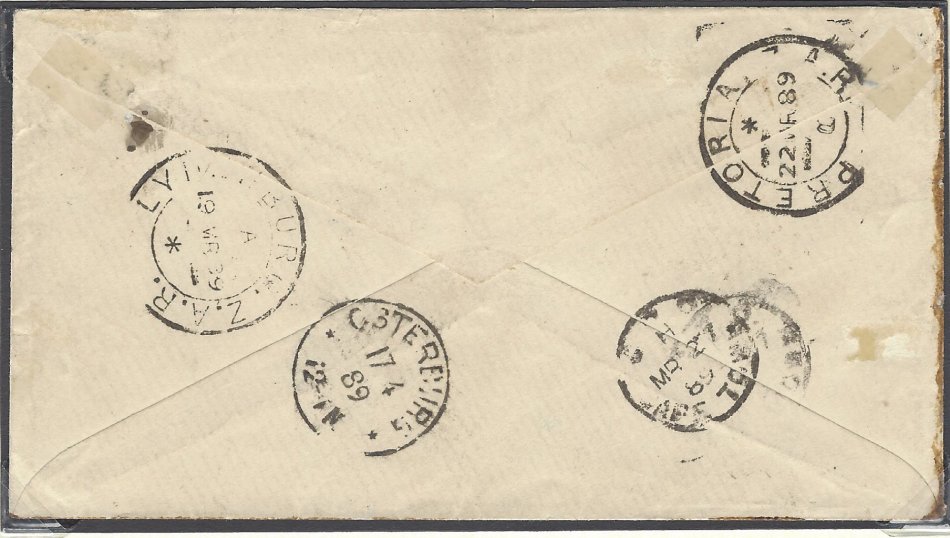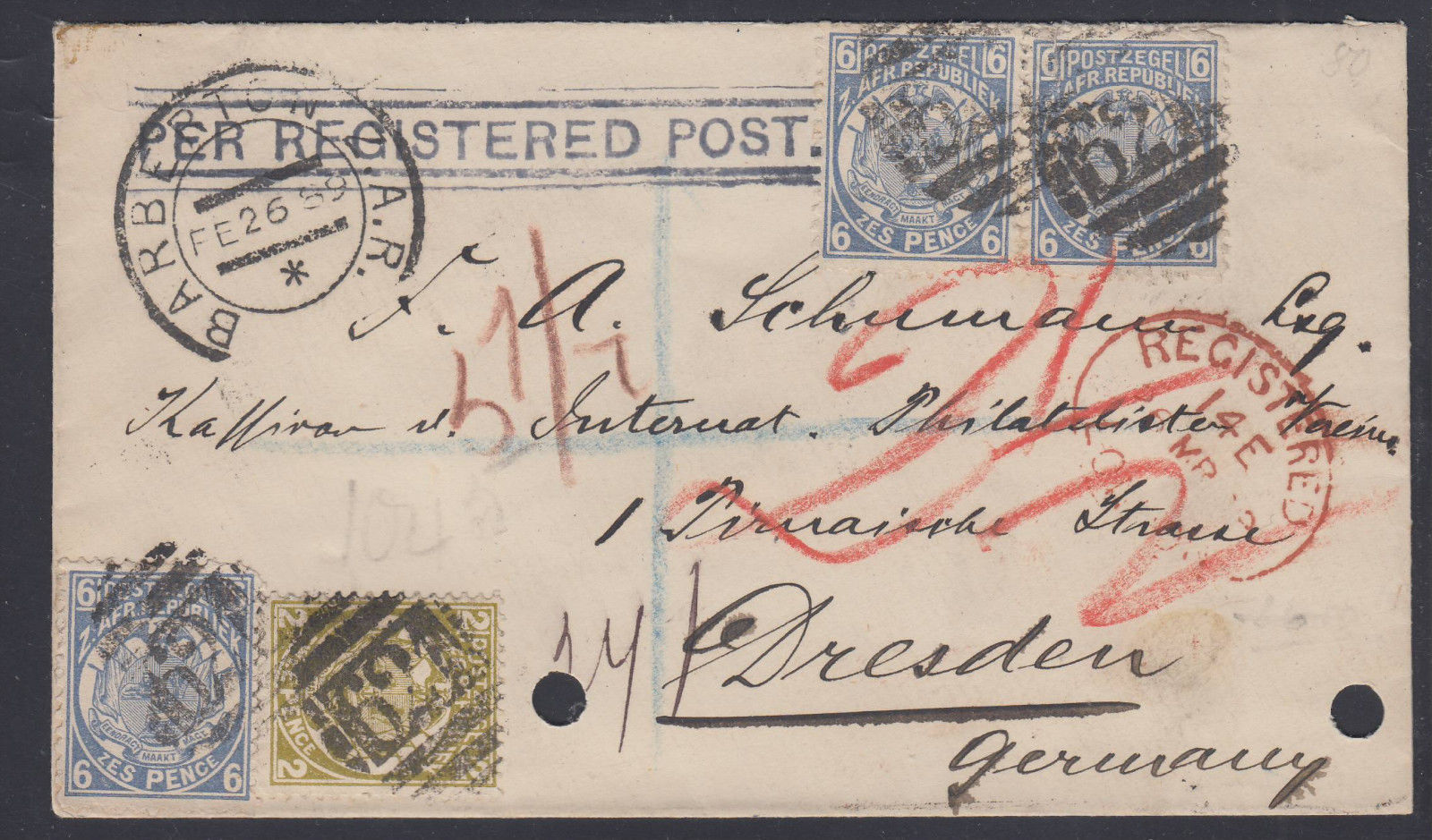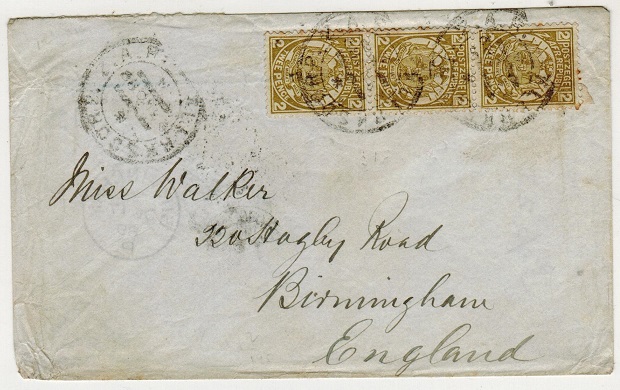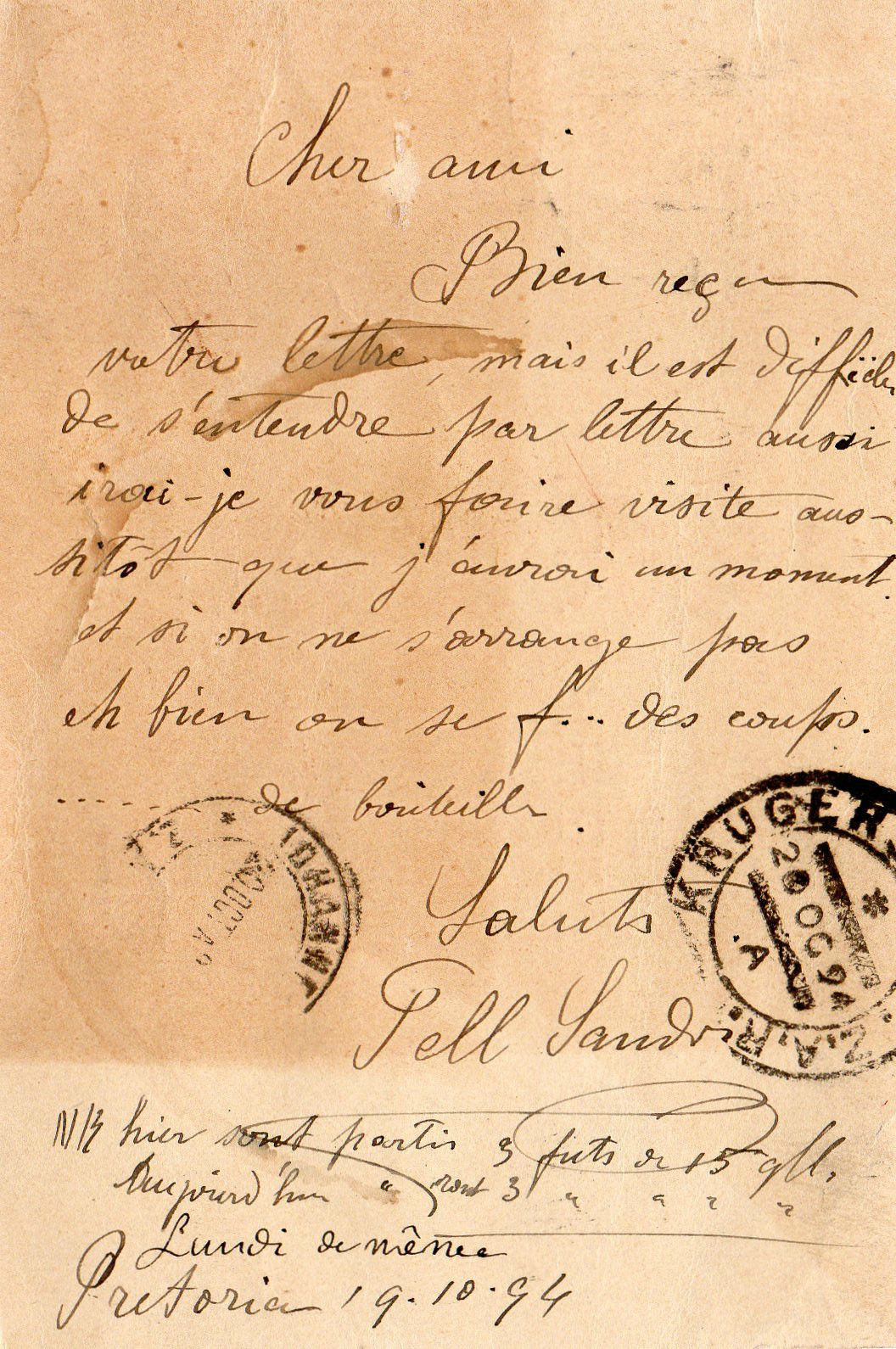Cape of Good Hope Truncated Double Circle Datestamp - 1890
Quote from Steve on October 2, 2020, 4:52 pmThe Truncated Double Circle Datestamp
The TDCD was, according to Goldblatt, first issued to the GPO Cape Town in 1890. I am not sure what the origins of this datestamp are. I have not read that it is a copy of a British design. Only the GPO Cape Town and the Graaff-Reinet post office were issued with it.
There are differences between the two datestamps whose inner circle is divided in three parts by two thick horizontal bars. The bottommost third is empty in the Cape Town version while Graaff-Reinet's includes a star. The date is displayed between the two bars. I have seen the date displayed as either day or month first in Graaff-Reinet's datestamp but not yet in Cape Town's. Below the base of its inner circle Cape Town's TDCD has an often filled rectangle, possibly a St. Andrew's Cross, above the truncated part of the outer circle. Unlike Cape Town's Graaff-Reinet's TDCD has CGH after its name and its star at the base of the inner circle.
This odd datestamp with its truncated outer circle led me a merry dance for several years. Whenever I found a copy the trucated part of the circle was invariably off the cover of the postcard, totally negating its value as a display item and consequently as a purchase. I wondered if I would ever find a complete postmark but eventually I did. Given the much smaller volume of mail processed by the Graaff-Reinet post office, its TDCDs are the hardest to find. The Cape Town TDCD is uncommon but not scarce. A good Graaff-Reinet TDCD is arguably the more valuable.
The Truncated Double Circle Datestamp
The TDCD was, according to Goldblatt, first issued to the GPO Cape Town in 1890. I am not sure what the origins of this datestamp are. I have not read that it is a copy of a British design. Only the GPO Cape Town and the Graaff-Reinet post office were issued with it.
There are differences between the two datestamps whose inner circle is divided in three parts by two thick horizontal bars. The bottommost third is empty in the Cape Town version while Graaff-Reinet's includes a star. The date is displayed between the two bars. I have seen the date displayed as either day or month first in Graaff-Reinet's datestamp but not yet in Cape Town's. Below the base of its inner circle Cape Town's TDCD has an often filled rectangle, possibly a St. Andrew's Cross, above the truncated part of the outer circle. Unlike Cape Town's Graaff-Reinet's TDCD has CGH after its name and its star at the base of the inner circle.
This odd datestamp with its truncated outer circle led me a merry dance for several years. Whenever I found a copy the trucated part of the circle was invariably off the cover of the postcard, totally negating its value as a display item and consequently as a purchase. I wondered if I would ever find a complete postmark but eventually I did. Given the much smaller volume of mail processed by the Graaff-Reinet post office, its TDCDs are the hardest to find. The Cape Town TDCD is uncommon but not scarce. A good Graaff-Reinet TDCD is arguably the more valuable.
Uploaded files:Quote from Bas PAYNE on October 2, 2020, 7:32 pmIt's worth putting this in a broader context ...
The TDC was introduced a couple of years earlier in the ZAR, suggesting that the Cape may have coped it from the ZAR. Though labelled "experimental" by George van den Hurk (The Transvaal Philatelist 28:93-105), it was used at nine offices in the ZAR, and was in use for several years at some of these offices. The date ranges given by van den Hurk are:
Barberton: June 1888 - May 1894 (+ museum example which may not reflect real use: September 1894)
Boksburg: October 1888 - (museum example which may not reflect real use: February 1895)
Johannesburg: June 1888 - August 1895
Klerksdorp: June 1888 - February 1890
Krugersdorp: February 1889 - October 1896
Lydenburg: November 1888 - July 1895
Marabastad: July 1888- January 1895
Potchefstroom: November 1888 - March 1893
Pretoria: July 1888 - May 1889
(In some cases recent finds have slightly increased these date ranges; in others, e.g. Johannesburg, the range may have been much less than the range given here.)
The top and bottom segments may contain a six-pointed star, a "time index letter", or be left blank. As van den Hurk comments, little is known regarding the use of these "time index letters" in the ZAR.
Here are some examples:
It's worth putting this in a broader context ...
The TDC was introduced a couple of years earlier in the ZAR, suggesting that the Cape may have coped it from the ZAR. Though labelled "experimental" by George van den Hurk (The Transvaal Philatelist 28:93-105), it was used at nine offices in the ZAR, and was in use for several years at some of these offices. The date ranges given by van den Hurk are:
Barberton: June 1888 - May 1894 (+ museum example which may not reflect real use: September 1894)
Boksburg: October 1888 - (museum example which may not reflect real use: February 1895)
Johannesburg: June 1888 - August 1895
Klerksdorp: June 1888 - February 1890
Krugersdorp: February 1889 - October 1896
Lydenburg: November 1888 - July 1895
Marabastad: July 1888- January 1895
Potchefstroom: November 1888 - March 1893
Pretoria: July 1888 - May 1889
(In some cases recent finds have slightly increased these date ranges; in others, e.g. Johannesburg, the range may have been much less than the range given here.)
The top and bottom segments may contain a six-pointed star, a "time index letter", or be left blank. As van den Hurk comments, little is known regarding the use of these "time index letters" in the ZAR.
Here are some examples:
Uploaded files:
Quote from yannisl on October 2, 2020, 8:16 pmGood observation. There is a similar situation with square octagon, which was widely used in the Orange Free State, and saw limited use in the ZAR. They were probably also used in Europe at the time or earlier.
This was also a time that there was talk of establishing the South African Postal union and it was likely ideas and costs were exchanged. One must note that these designs were not really innovations of Postmasters, but driven by the manufacturers of the datestamps. Frescura wrote that maybe there was an attempt to establish a regional identity, but I have my doubts.
As to the word experimental is more a term to describe the group than really "experiments".
Good observation. There is a similar situation with square octagon, which was widely used in the Orange Free State, and saw limited use in the ZAR. They were probably also used in Europe at the time or earlier.
This was also a time that there was talk of establishing the South African Postal union and it was likely ideas and costs were exchanged. One must note that these designs were not really innovations of Postmasters, but driven by the manufacturers of the datestamps. Frescura wrote that maybe there was an attempt to establish a regional identity, but I have my doubts.
As to the word experimental is more a term to describe the group than really "experiments".
Quote from Steve on October 3, 2020, 10:55 amMany thanks Bas and Yannis.
These are good examples of the ZAR TDCD, Bas. With regards to this datestamp, putting it in a ZAR context is very helpful. Thanks. However, I feel that your advice, while valuable as it is to Cape collectors, is rather lost in this Cape section. If I was to create a ZAR / TVL Experimental Forum, would you be willing to post it there as well where it would be found more easily by ZAR / TVL collectors?
I can see that someone is going to have to rewrite this Cape TDCD subject based on the preceding info. It would be a coup to show that the Cape TDCD was based on a ZAR design. That would be something for the books. Ditto the SOD in the OFS. I don't know of anyone else making this suggestion. Are you the first, Bas? If so, as Yannis says, a "good observation" and congratulations.
I have been wondering about the manufacturers of datestamps attempting to sell new or failed designs to the colonies. Do we have any names for the manufacturers of datestamps and can we tie them to products used by the various Colony and State PO.s in South Africa? I am not suggesting we get too deeply into this but is seems a failing to study datestamp postmarks but not include brief details of the manufacturers.
Many thanks Bas and Yannis.
These are good examples of the ZAR TDCD, Bas. With regards to this datestamp, putting it in a ZAR context is very helpful. Thanks. However, I feel that your advice, while valuable as it is to Cape collectors, is rather lost in this Cape section. If I was to create a ZAR / TVL Experimental Forum, would you be willing to post it there as well where it would be found more easily by ZAR / TVL collectors?
I can see that someone is going to have to rewrite this Cape TDCD subject based on the preceding info. It would be a coup to show that the Cape TDCD was based on a ZAR design. That would be something for the books. Ditto the SOD in the OFS. I don't know of anyone else making this suggestion. Are you the first, Bas? If so, as Yannis says, a "good observation" and congratulations.
I have been wondering about the manufacturers of datestamps attempting to sell new or failed designs to the colonies. Do we have any names for the manufacturers of datestamps and can we tie them to products used by the various Colony and State PO.s in South Africa? I am not suggesting we get too deeply into this but is seems a failing to study datestamp postmarks but not include brief details of the manufacturers.





